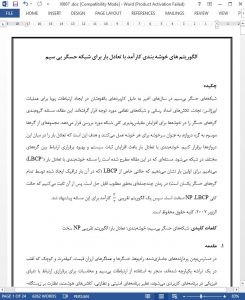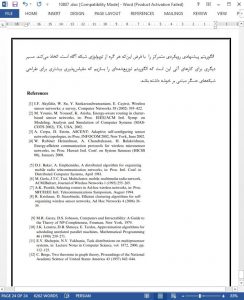Abstract
Wireless sensor networks have been receiving increasing attention in recent years due to their potential applications in the establishment of dynamic communications for emergency/rescue operations, disaster relief efforts, and military networks. In this paper, we investigate the problem of grouping the sensor nodes into clusters to enhance the overall scalability of the network. A selected set of nodes, known as gateway nodes, will act as cluster-heads for each cluster and the objective is to balance the load among these gateways. Load-Balanced Clustering increases system stability and improves the communication between the various nodes in the network. We call the problem addressed in this paper as the Load-Balanced Clustering Problem (LBCP). We first show that a special case of LBCP (whereby the traffic load contributed by all sensor nodes are the same) is optimally solvable in polynomial time. We next prove that the general case of LBCP is NP-hard. We then proposed an efficient -approximation algorithm for the problem.
1. Introduction
The availability of cheap, low power, and miniature embedded processors, radios, sensors, and actuators, often integrated on a single chip, is leading to the use of wireless communications and computing for interacting with the physical world in applications such as security and surveillance applications, smart classroom, monitoring of natural habitats and eco-systems, and medical monitoring. The resulting systems, often called wireless sensor networks, differ considerably from current networked and embedded systems. They combine the large scale and distributed nature of networked systems such as the Internet with the extreme energy constraints and physically coupled nature of embedded control systems.
8. Conclusion
In this paper, we address a problem that arise in the design of cluster-based wireless sensor networks. In particular, we consider the problem of assigning sensors to gateways in a wireless sensor network with the objective of distributing the traffic load among the gateways so as to ensure that no gateway is overloaded. We show that this problem is optimally solvable in polynomial time if all sensors have Uniform Traffic Load. However, the problem turns out to be NP-hard if the sensors have differing traffic loads. We proposed an approximation algorithm for the NP-hard problem and prove that our proposed algorithm is able to guarantee a performance ratio of 3/2 . Empirical studies have shown that our proposed algorithm is able to perform much better on the average as compared to the worst-case performance ratio derived. Hence one direction for future research is to analyse the average-case performance of our proposed algorithm. Our proposed algorithm adopts a centralized approach which assume that each node is aware of the network topology. Another direction for future work is to develop a distributed algorithm which would be more scalable for the design of cluster-based sensor networks.











